Archive for the ‘(Desi)Mom’s Guide To’ Category
The Hundred Languages
Author: utbt14 Feb 2014
I am training the second child. Given a word, she needs to write one sentence with the word in it.
She was struggling. When I asked her what is wrong she explained patiently, ‘Amma, when you say ABOVE, the photo that comes to my mind has a red house with bird circling above it, children playing in front, tall trees from the backyard with branches spreading on the top floor. How do I put all this in ONE sentence?’
I felt like some one slapped me and I remembered this speech by Loris Malaguzzi, the founder of Reggio Emilia Approach.
The Hundred Languages
No way. The hundred is there.
The child
is made of one hundred.
The child has
a hundred languages
a hundred hands
a hundred thoughts
a hundred ways of thinking
of playing, of speaking.
A hundred always a hundred
ways of listening
of marveling, of loving
a hundred joys
for singing and understanding
a hundred worlds
to discover
a hundred worlds
to invent
a hundred worlds
to dream.
The child has
a hundred languages
(and a hundred hundred hundred more)
but they steal ninety-nine.
The school and the culture
separate the head from the body.
They tell the child:
to think without hands
to do without head
to listen and not to speak
to understand without joy
to love and to marvel
only at Easter and at Christmas.
They tell the child:
to discover the world already there
and of the hundred
they steal ninety-nine.
They tell the child:
that work and play
reality and fantasy
science and imagination
sky and earth
reason and dream
are things
that do not belong together.
And thus they tell the child
that the hundred is not there.
The child says:
No way. The hundred is there.
-Loris Malaguzzi (translated by Lella Gandini)
Founder of the Reggio Emilia Approach
L Is For LOW-Tech Early Experiences, Vital Need For The Future
Author: utbt18 Jul 2012
“Children live through their senses. Sensory experiences link the child’s exterior world with their interior, hidden, affective world. Since the natural environment is the principal source of sensory stimulation, freedom to explore and play with the outdoor environment through the senses in their own space and time is essential for healthy development of an interior life…. This type of self-activated, autonomous interaction is what we call free play. Individual children test themselves by interacting with their environment, activating their potential and reconstructing human culture. The content of the environment is a critical factor in this process. A rich, open environment will continuously present alternative choices for creative engagement. A rigid, bland environment will limit healthy growth and development of the individual or the group.”
— Richard Louv in THE LAST CHILD IN THE WOODS
Rich natural environment = sand pit or water table.
Rigid bland environment = ipad, TV.
Child Sexual Abuse Awareness Workshop
Author: utbt25 Jun 2012
was organized in our community.
Chula has been wanting more independence. She calmly stated that she would like to walk to and back from the bus stand/park by herself and would also take responsibility for her younger sister. ‘Amma, I am ready amma’, she said! Apart from standing in the balcony with my binoculars (ahem…., yes I do that), I thought that I need to do few more things to equip them. Starting point of which was organizing the CSA workshop for my children and for the other children in my community.
I don’t know if it is the SMJ effect, ppl were flocking to sign up. Alas, no two families have the same schedule! So many emails later, we were able to agree on a time that was convenient for at least 1/3 rd of the parents who were interested.
Viji Ganesh conducted the session for about 15 chidlren in the 6 – 10 year old age range.
Some interesting snippets from the workshop:
* VG: Can you think of some body parts, when touched by other people, make you feel uncomfortable?
Chula: (Loudly) Yes. My underarms.
(Okay, Viji, we might need a few more sessions for this one.)
* VG: When some one is giving you an uncomfortable touch, what do you do?
Child 1: Kill him?
Child 2: Hit him between the legs and run away.
Child 1: If we are next to the swimming pool, and if he does not know swimming, push him in to the water.
Child 1: Shoot him with a gun.
Child 1: If he likes chocolate, poison his chocolate and kill him.
Child 1: Touch his pressure point and he will collapse.
To me, all the killing and out of the world ideas aside, it was interesting to note that all children used HIM in association with the abuser! Viji quickly caught on to it and said, ‘adult’, can be a woman or a man, sometimes even a older child.
Viji is good. She conducts these workshops in schools as well as in communities. If you are in Hyd get in touch with her organize a session in your community or your child’s school.
Standing Up For Our Children
Author: utbt6 Sep 2011
You have touched upon a couple of things that I have in my mind for the past six years. Let me go paragraph by paragraph. Any one else from the blog-mom-o-sphere, please participate. Comment, do a post, what ever works for you.
Chula has been fitting in a size or two bigger clothing since she was four. It is the hips that take the blame. Till I shopped in the ‘toddler’ section(US size 2 – 5) life was peachy. When I ventured in to the ‘girls’ section (US size 5 – 14) I vividly remember being alarmed. Many of the clothes were inappropriately designed. I mean who ever came with this low rise jeans idea?! Shouldn’t designers have some basic sense about hip size : crotch-to-waist length holy ratio? One moron comes up with a design that would fit stick figures and the all major departmental chains go ballistic and stock ONLY low rise hip huggers. I mean these are 5 and 6 year old children who run and climb things. I tried buying two sizes bigger and altering the length, but eventually gave up buying jeans for my children. Since 2008, all they wear are cotton pants with elastic at the hips that covers the butt crack. Yes, the clothing section is brimming, but if you are looking for non-pink, non-Disney characters, slightly loose, appropriate clothing, something that will withstand the running and climbing, something that is not a mini version of adult clothing you might as well grow you own cotton and weave your own clothes.
Do I need to write anything about swim suits? Target has decided that if you are looking for 8+ size swim suit, it has to be three piece – a mini bra, a bottom that will fit inside a match box, a small match box that is, and a shirt. Mind you, none of these three pieces of clothing solve the purpose of covering your child’s body and it costs a about $50. If not, you can buy wet suits for double the prize. Finally after three months of searching I found swim shorts(low rise of course) and swim shirt at Old Navy, that too only because Feb is the time the stores stock swim wear.
Yes, that is the trend now good people. The thinking is no more, ‘This is current fashion’/‘this is swim season’ -> let us buy a little more in case there is a demand. The selling no longer caters to the different sets of people, with different shapes of bodies, buying a variety of things. For all that talk and noise about uniqueness, the only message clothing industry gives my children is to conform. Stores sell one standard thing at one standard time and you better stock up. If they sell low rise jeans, fit your body in to it. If they sell swim suits from Feb – July, buy at that time. If you think your child might grow out of the swim suit before, what stores perceive as, the next swim season, you stock up or you don’t get any. All in the name of popular demand!
Not exactly clothes, but while on the topic, I might as well spill my angst. If you are following this blog you will know that we just moved continents. Moving two children from one country to another, for good, is not fun. I wanted to cheer the children up and the bulb in my head switched on. ‘Hey, let me buy the children their own pull along suitcases.’ Again if you don’t endorse Disney or Barbie, then your choices are practically non existent. For boys it is easy, buy a pull along suitcase with Lightning McQueen and you are done. At least that is what it looks to me as a mother of two girls. What I buy is what I endorse to my girls. I do not want to endorse Disney Princesses, Bartz, Barbie and such. I found that if I have certain principles, then I enter in to the exclusive realm and I need to shell out the money even if I am not ready. Finally this came home, with a hefty price tag, of course, the most I have ever spent on a piece of luggage and my heart bleeds a little bit every time the children pull it a little too hard.
Good teachers/guides(parents are the first teachers and guides of young children) have this philosophy, to balance out the classroom and to maintain harmony in the classroom, they pair up children with opposing qualities. It is purely trial and error and if it clicks, they compliment each other very well. Now a small diversion. Children are born with no clue what so ever about the XX and XY factor. Finally they figure out that there is a divide called girls and boys. They look in the society and look for external signs and qualities that define what is a boy and what is a girl. Unfortunately society tells that girls NEED to wear pink, wear dresses, must giggle, form sisterhood, like chocolates, must be super sensitive, swing between extreme emotions, be delicate, do art work, talk about their feelings, give up things for the greater good, be responsible, be gentle, be caring…… Back to good teachers/guides, these good adults must bear in mind that young children gravitate to pink and pretty because in their flexible minds, if they do not they are not girls. Unfortunately the adults, innocently endorse this thinking that it is a phase. Yes it is a phase, but if dealt blindly becomes a way of being, way of existence. All it takes -sensible adults to keep reassuring that sex is a biological thing and does not change no matter what. Just like good teachers, good parents must expose their children to both ‘boy stuff’ and ‘girlie stuff’.
Media, again like the departmental stores works with the sole principle of making money. Boys play rough/girls read books and do crafts -> publish more books for girls with girls as central characters and balls/blocks and video games for boys. Now come in the unsuspecting adults, who look at the choices available – ‘Make your own friendship bracelets kit with pictures of a pretty girl’, Cam Jansen, Fancy Nancy in full splendor, ‘Monopoly in pink – special girls edition with boutiques and malls instead of hotels and houses’, designer edition pink Scrabble, Uno special pink edition… and end up thinking this is what girls need and inadvertently end up feeding the loop. Whose brilliant idea is it to sell Monopoly in pink? What is this message that girls must shop and spend money at the mall while boys get to do large motor activity, running around, playing regular Monopoly and developing their spacial skills? Why define pink is for girls and then sell pink board games and giving the message that girls play with girls and boy play with boys? Who exactly dictates that boys need to be powerful and play ball while girls need to be passive aggressive and shop?
Then this unique Indian message. The MIL switches the TV on and there is a lady lecturing that, the woman’s place is behind the man and by supporting the man she can better herself. She goes on telling the story of Valluvar’s wife Vasuki who defied gravity. At a point it gets to me, the mother of two girls and I end up buying Paper Bag Princess where the Princess not only saves the goofball of a prince but also ends up calling him a bum and walks out alone. Do I want to my daughters to end up alone? No, but I feel that is much better than being a Vasuki or a dainty princess. This is exactly how aggressive feminism grows. The past six years I have heard nothing but the roles and duties girls. Come on, my child is still pooping in her diapers and you tell me, ‘It is good to have a girl child first, she will be responsible and take care of the boy who will come next’?
That is why K’s mom, it is up to us, parents to stand up for our children, so that they can be well rounded individuals, have a full life, without any hatred for the opposite sex, choose professions that they are passionate about rather than to fit the bill and be sensitive. We as parents must put thought in to what we buy and what we endorse. Rather than picking the best of the worst, we must demand quality. If we let the advertising industry and corporates dictate what we need to buy for our children, we(men and women) might as well part ways, move to Mars and Venus and live happily ever after.
Reading suggestions: CINDERELLA ATE MY DAUGHTER by PEGGY ORENSTEIN. Words can’t tell how much I enjoyed and learned from this book. Five stars and a must read for all parents, irrespective of the sex of your child.
Previously blogged
Sexualization Of Young Children
Are men really from Mars and women from Venus?
Creating Art Space For Children
Author: utbt15 Aug 2011
Part 7 of many.
Tharini, this is for you. What now seems like ages ago, I promised you that I will do a post on setting up an art space for children. Months passed and you have already created an art space for the boys….Better late than never and never to break promises….so here it goes.
Let us begin with the basic premises:
– It is the process, not the product.
– You are aware of your child’s age, capabilities and interests.
Age: Which means that your very young child will not have a sense of boundary. Provide her with a big canvas. Do not give her a 8 X 11 and expect her to create within it.
Interest: Some children do not like wet paint. It does not make them any less of an artist.
In my opinion for children age 2yrs – 6yrs, the popular art activities are play dough, cutting, pasting, crayons, wet paint, shaving cream, stamping. I have two or three variations of these in my art shelf and keep rotating them. A simple change paves way for new creative energy. Some typical things I rotate are
Playdough
Week1 – Play dough + roller and cookie cutter
Week2 – Play dough + moulds
Week3 – Playdough + extruder
Wet paint variations
Week1 – finger painting
Week2 – brushes
Week3 – spin art
Week4 – liquid water color
Regarding colors, there are philosophies about what we must give children. Montessori believes in starting with one color at a time, because the children must enjoy the process – fluidity of paint, hand eye coordination, brush control and learn their boundaries. Giving them too many colors distracts them from the process. The second step would be to give them the primary colors ONLY and let them create the secondary colors. Waldorf believes in chunky crayons in all colors and emphasizes pastels in their environment. So pick something practical that would work for you.
I knocked off the doors of a dining nook, which gave me two decent sized shelves. To organize, I picked up four file trays from IKEA. Right next to the shelves I placed our IKEA easel. Voila, our art space. Now some pictures for you.
One side printed paper, some collage material I find interesting, paper grocer bags cut and flattened, construction paper are the other supplies I have in the trays.
Good luck with your art space peeps!
M Is For Montessori
Author: utbt28 Mar 2011
Montessori is a philosophy. I consider it as a ‘way of life’ as opposed to ‘alternate schooling method’.
Magic number in Montessori – 3.
- Montessori believes that children’s development is in stages of three. 0-3 is the infant/toddler stage or the unconscious absorbent mind, 3-6 is the conscious absorbent mind. The 6-9(lower elementary) and 9-12(upper elementary) phases in a Montessori elementary focuses on helping children organize his/her thoughts internally. It is considered the period for social development and evolving a sense of justice.
- Even the lessons that are taught to children are taught in a format called ‘three period lessons’. The first period is the teacher introducing the child to the work. The second period is the teacher assessing how much the child retained from the first period and how much the child recognizes the elements of the lesson. During the third period the child is encouraged to do the lesson by herself, recalling all the elements and the vocabulary. If desired results are achieved, the lesson is considered complete. From this point onwards the child can repeat the work as and when desired.
- In the very core, Montessori regards a human brain to have three components – reptilian, mammalian and evolved. This is true to all human beings. What we exhibit is a complicated interplay of all these three tendencies.
- Shelves that are partitioned in to three levels with three objects/work displayed in each level.
Mixed age classrooms. Younger children and older children working together is a typical trait of a Montessori classroom.
Montessori classroom, often called as an environment, is divided in to practical life area, sensorial area, language area, cultural area and math area. In practical life children learn things like pouring from one cup to another, the hand control and hand-eye coordination learnt from this process is later applied to writing. Every area is interlinked. Though a typical Montessori classroom is a big hall with 50 – 55 children of mixed age, the children magically segregate themselves in to age appropriate areas. Younger children are almost always found in the practical life area, the older children in the math area and such.
Motto behind the Montessori environment is ‘everything has a place and everything in its place’. Same applies for children and teachers in the environment. The teacher’s place – to observe and to guide. The children find their own place in the environment. Coming in to a Montessori environment the children are taught by modeling – by both the adults and the other children in the environment. The new child finds where she fits in this well organized environment and slowly grows from a novice to a leader.
Montessori considers 0-6 years of age as a unique window. It is known as ‘sensitive period’. Through her environment, the child is forming experiences which play a major role in how the neural networks are formed in the brain. By four these neural networks are precipitating and it becomes increasing difficult to rewrite the neural patterns. That is why many Montessori schools have an age limit after which they do not take non-Montessori children in to their environment.
Montessori places great deal of respect on sense of order, which is innate in a child. The first three years, all the child does is to make sense of the world and create order within herself. Sense of order in simple words can be explained as ‘where everything goes and when everything happens’. Though she cannot tell time, the child has a concept of time. Example, nap after lunch, dinner after going to the park, read books before bed etc. When the environment is predictable – few things, each in its place, well displayed, the child is more confident in the environment. Care must be taken to respect the child’s sense of order.
Many steps exist in a work and this is called cycle of work. If the child wants to paint, the cycle is -> get the apron on -> get paper -> pick paint -> paint -> place art work on drying shelf -> get water in a pail/container to clean easel -> dry the easel with a towel -> dump dirty water -> dry the container -> place all material in respective places (used towel in laundry basket, hang apron on peg, used paint cup and brushes in the sink). Every adult unfamiliar with Montessori to whom I have explained this cycle, have expressed doubts like , ‘this is too restrictive/child will feel burdened/are you for real?/this will never work’ etc. But I have seen 18 month – two year old children who do this without missing a beat. The main thing to recognize is that the doubt lies not within the child, but within the adult. The adult’s contribution to make sure that the child progresses successively without breaking the cycle of work is, to do the work once herself, think through the steps bearing in mind the age of the child, make sure that everything is available in the right place in the environment – like the paper is trimmed to size and placed on the paper tray, paints are filled regularly, dirty paint cups/brushes are cleaned and replaced, art work drying rack is accessible, towels are filled in the hamper, sink/faucet is easily accessible. I have also heard arguments that it is too much to expect from a child. I disagree. We talk about gratification and this is how a child learns gratification. Children learn their boundaries, which is not at all negative. Not to mention they expand their mind to the thinking that a certain problem has many steps and vice versa are aware that the small steps lead to a bigger picture.
Montessori environment places high emphasis on grace and courtesy. The idea is to teach through example that every person, every object, every process needs to be respected. This simple thing has deeper spiritual meaning. I can almost draw a curriculum web based on this.
Montessori, considers everything as work and every work is done in a certain way. In a manner of speaking even play is work and children are expected to play without harming themselves or their friends.
Montessori is based on reasoning and believes that fantasy can wait till the child is six and is capable of recognizing fantasy. As I have told many times, this does not make the children deficit of imagination and creative thinking. If a child is inclined to enjoying fantasy, even if they are Montessori schooled, they grow in to adults with logically sound fantasies. My most famous argument, ‘logic can exist without fantasy, but fantasy cannot exist without logic’. As an extension of this, tech toys, the iPads, iPhone apps and such are frowned upon. Because a young child needs to recognize not just cause and effect, but also a reason for this. All tech toys do is to teach children that things happen, take it for granted and don’t ever try to open your toy and analyze why and how.
Movement is incorporated in to the process of learning. Movement molds brain development in wondrous ways.
Montessori environment is filled with non-plastic objects, earth tones, no bright over stimulating colors, wooden materials, natural fabrics and such.
Montessori is neither strict nor all play. I like to think of it as flexibility within a structure.
Many more things to say, but I leave you all with this: any philosophy is only as sound as the adult who implements it.
Of Extra Classes, Pushing Kids And Parenting Styles
Author: utbt13 Jan 2011
Yesterday was Chula and Mieja’s first day taking swim lessons. I posted in the school’s parent yahoo groups, made couple of phone calls and registered them in a highly recommended swim school. They have classes once a week for 30 min. So I was fully aware that the money spent is for them to monkey around in water, which they did and had lots of fun. Well, I can dream that they freestyle across the Suez canal after these ten, once a week, thirty min classes, but again it will be just a dream.
Now I have to mention that of my M.A.N.Y pet peeves, one that will rank number one is my obsession towards maintaining a schedule and the other one that will be in the top ten is public water facilities.
My schedule goes like this:
– Swim class at 5.30PM = We have to leave home at 5.00PM.
-Leave home at 5.00PM = we must be ready dressed + kids’ back packs packed + their after swim snack ready + boots on + jackets on + customary potty round etc done by 4.55PM.
-Back pack ready at 4.55PM = start packing back pack at 4.30PM.
-They need to have a substantial snack before swim and it must be at least 90 min before the swim. So biggish snack/light early dinner at 4.00PM.
-Eat at 4.00PM = dinner, snack all done by 2.00PM. So I can go pick them up at 3.00PM. (Now if some one points out to me that we live exactly 1.8 miles away from school and it takes exactly 6 minutes one way even if all the four traffic lights are on, I will have to ask you to shut up and refer you to my pet peeve # 1. It has to be like this only.)
-I can hear the clock ticking, every second passes with an ominous thud, I am moving at warp speed, but the rest of family is not. So I feel this enormous pressure of carrying every one through my schedule in order to achieve the deliverable. Working on that folks…. might take a life time though.
Now to my next pet peeve about public water facilities. My most traumatic life experience so far, is that I had to dip in sea at Rameshwaram in order to ward off the ill effect of some planet in my husband’s birth chart. I consider it atrocious that I had to do it with him just because we are married. The very fact that I was forced to do it, created many ill effects for the husband that were not in his birth chart. Pity-huh?!
I see in water, things that no one can possibly see with their normal eye. I imagine one person swallowing water and coughing it out and their germs coming to me/my children crawling in slow motion with Jaws music playing inside my head. The funny thing is that I am not your typical Purell worshipper. Water just seems to enhance my out of the box thinking.
So after the swim class, I washed, dried, dressed, blow dried the girls’ hair once at the pool side. Brought them home, dumped them directly in to the tub, shampooed their hair, scrubbed the top layer of skin off, rinse, repeat, ditto at home. Then the usual smahan after hair bath, churanam to clear sinus, blow dry their hair, moisturize etc etc ritual followed. Of course, I have a target bed time, so all this scrubbing activities have to be reverse engineered and timed accordingly. You all get a fair idea of how things roll right?
By 8.00PM, I was a wreck. I felt like eating murukku….. chewing the crispy, fried, oily snack seems to be the perfect solution to get rid of all that stress. Unfortunately there was no murukku at home and so the husband was collateral damage to the process of de-stressing.
The bigger point to all this is……. (yes, however pointless all this seems there is a point peeps) taking the children to an activity that I am not comfortable in is ‘this’ hard for me. I usually stick to my comfort zone of art, dance and dabble a little bit in music. The rest is like pulling a huge stone uphill by tying it to my hair. So hats off to the parents, Chinese and others, who are very sure about their choices for their kids and go through the hassle of taking them to various classes and putting in the grueling hours of practice and such. Amy Chua might call me lazy, but it is like that only. I just want to choose my battles.
PS: My opinion about Amy Chua’s article:
I didn’t like the stereotyping. For example, Asian kids play video games, do sleep overs and have extra curricular activities that Amy Chua may not approve of. She just translated what she did at home to all Asians.
I admire her guts for telling out in the open what she believes in.
I agree that Asian parents have high expectations on their children, while some non-Asian parents might be afraid to have any kind of expectations on their children. It is not wrong to have expectations.
I also agree that children need to be presented the same activity many many times before they master it and are very comfortable in it. But every parent does ‘the presentation’ in different ways. Not all Asian parents yell and go on a war path.
God give me strength to not call my children garbage, however testing their behavior is.
Whatever you do, do it with conviction. Example, the worst will be a ‘typical’ Asian parent parenting the ‘typical’ western way and expecting the result of ‘typical’ Asian parenting and vice versa.
Gandhiji’s Birthday
Author: utbt5 Oct 2010
Gandhiji’s birthday is a big deal in our school. We start with International Peace Day on Sept 21, then we do Pennies For Peace, then we talk about Gandhiji – the peaceful warrior and end the peace/non-violence theme by celebrating United Nations Day. Our school is closed for Gandhiji’s birthday every year.
This has been our routine for the three years we have been with this school. But the girls are growing and this Oct 1st and Oct 2nd we had a lot of talk about Gandhiji at home.
Mieja’s questions:
Did a english man shooted Gandhiji?
An Indian man did? But, why Amma? Gandhiji is the father of India. Why would the ‘goat person’ kill his own dad?
Did Gandhiji die in the darkness or something? What time of the day was it?
When he was shooted, how did he fall?
Why is he dressed like that? He has no shirts? Was Gandhi poor? He had no money to buy shirts? Is that why he is naked?
Chula’s questions:
Why do you say Gandhi Jayanthi Amma?
Is it like Krishna Jayanthi? Does Jayanthi mean birthday? Chadurthi is Ganesha’s birthday too. So why are we not saying Gandhi Chadurthi?
Chula had her shower almost by herself and dressed up in a pattu pavadai. Then she came running to me and said that she was ready. When I asked her ready for what, she replied that she is ready to celebrate the jayanthi or chadurthi or whatever it is, demanded why I haven’t set up Gandhiji’s picture, decked it with flowers and wanted to know what special Gandhi food I had cooked.
I promised her we will do something special in an hour and quickly planned some art work, books, songs and special food.
The food part was the easiest – peanut sundal and milk. One more thing to love about Gandhi, it is so easy-peasy to prepare his favorite food. Chula wanted to sing Ragupathi Raghava, so we did that. We read Marching To Freedom By Pratham, (special thanks to Chox aunty for sending special books to the girls) and Dandi March is making quite an effect in Mieja’s mind. I can sense questions brewing. We also have Picture Gandhi by Tulika, The Story Of Dandi March by Tulika and Gandhi: His Life In Pictures. We thumbed through all the books.
I have to admit that I was a little lost for the art part. Then I decided to talk about how simple lines can form a drawing, profile vs front view. I showed then the famous question mark profile drawing of Gandhi, how such simple lines can be representative of Gandhi. Mieja wanted to draw and Chula wanted to write an essay. So this is what we ended up doing.
I had been wanting to introduce the liquid water colors that I had purchased a few weeks back. So I did white on white crayon resist and told them that if they paint the canvas they will discover a surprise. They were kicked when they saw Gandhi on their canvas.
They wanted to experiment on crayon resist and this is what they came up with. They can draw themselves with long hair and long curly eye lashes even when they cannot see what they were drawing. LOL!
I Know What We Did This Summer – 1
Author: utbt11 Aug 2010
More summer fun 2010 posts.
Do you want to know?
Okay, I will give you a picture, can any one guess how we did this?
Thanks for your comments. It is spin art. I also showed them how to splash paint to add colors to the finished spin art. Kids were super excited and Chula kept saying, “Amma you are doing just like Jackson Pollack”. I have a feeling that this splashing will come back to bite me.
What is the deal with Google? They acquired Slide? Now I have this ugly super poke pets ad in the slide show. Click on the X to close the ad. Move mouse over the pictures for captions.
Art Games
Author: utbt9 Aug 2010
More summer fun 2010 posts.
So what does one do with two little girls for 10 weeks?
That is 70 days. Time up and awake comes to 840 hours.
TV/PBS kids games/Wii, not that big at home. It is mainly to give myself a break. We have only one reader and one that pretends to be a reader 🙂
We did the usual playdates, block building, drawing, coloring, free play, gardening, bubble blowing, side walk chalk, easel painting, rangoli, trampoline, bubble bath, wading pool, parks, hikes, bicycle ride around the neighborhood, libraries, museums, exploratarium, cross words, puzzles, I spy, planetarium, doctor office trips(Yep, double bronchitis for the whole family including the adults in the middle of summer! Who would’ve thunked?!) botanical garden, camping trips. Still did not add up to 840 hours! No siree Bob, it did not.
And that is when I read about the ‘Simon Says’ game and thought that it would be interesting to do at home. I wanted to do shapes – one shape a day. My main goal is to talk to the girls about the different shapes and for them to look around them and see what shapes they can identify in our environment.
The first day we did circles. Red circle, blue circle, multicolored circle, red circle inside a blue circle, how many circles can you fit inside the biggest circle, draw three circles all three touching, color the smallest blue circle, color outside the green circle….the girls just went with the flow and had a ball.
The next day we did hearts. The girls quickly took over. Heart = love. I love my family. ‘Mieja look I drew you in my heart, that means I love you’, ‘I am making a flower for you’, ‘I am drawing a family in love’….. I stepped back, picked up a book and answered only when I was specifically called for.
What did we do on the third day? Duh! Triangles, of course. Mieja had difficulty making the third line straight so that it intersected the first two, while Chula was already doing the triangle things she knows – pizza, triangle maze, ice cream cone, ice cream sundae, flower with triangle petals (okay that was a far one, but whatever) etc. So I had to branch off, giving different instructions for them. Chula wanted to warli. She did one warli image, then our family in warli holding hands and dancing. When she said that she wanted to do spiral warli, I made o-o-o-o-o-o- in a spiral and she figured out how to do the triangles and how to make them hold hands. She walked around the paper, rolled around the paper, looked at angles that would put a cinematographer to shame, but she did it. Mieja wanted to do warli family and was getting upset that she couldn’t do it like her sister. After much talking that it has to be ‘her’ work and must be something ‘she’ enjoys doing, she did do a family with square and rectangle bodies. But she was happy that she made her own family.
Fourth day we must have done squares. But we took a break 🙂

 (No Ratings Yet)
(No Ratings Yet)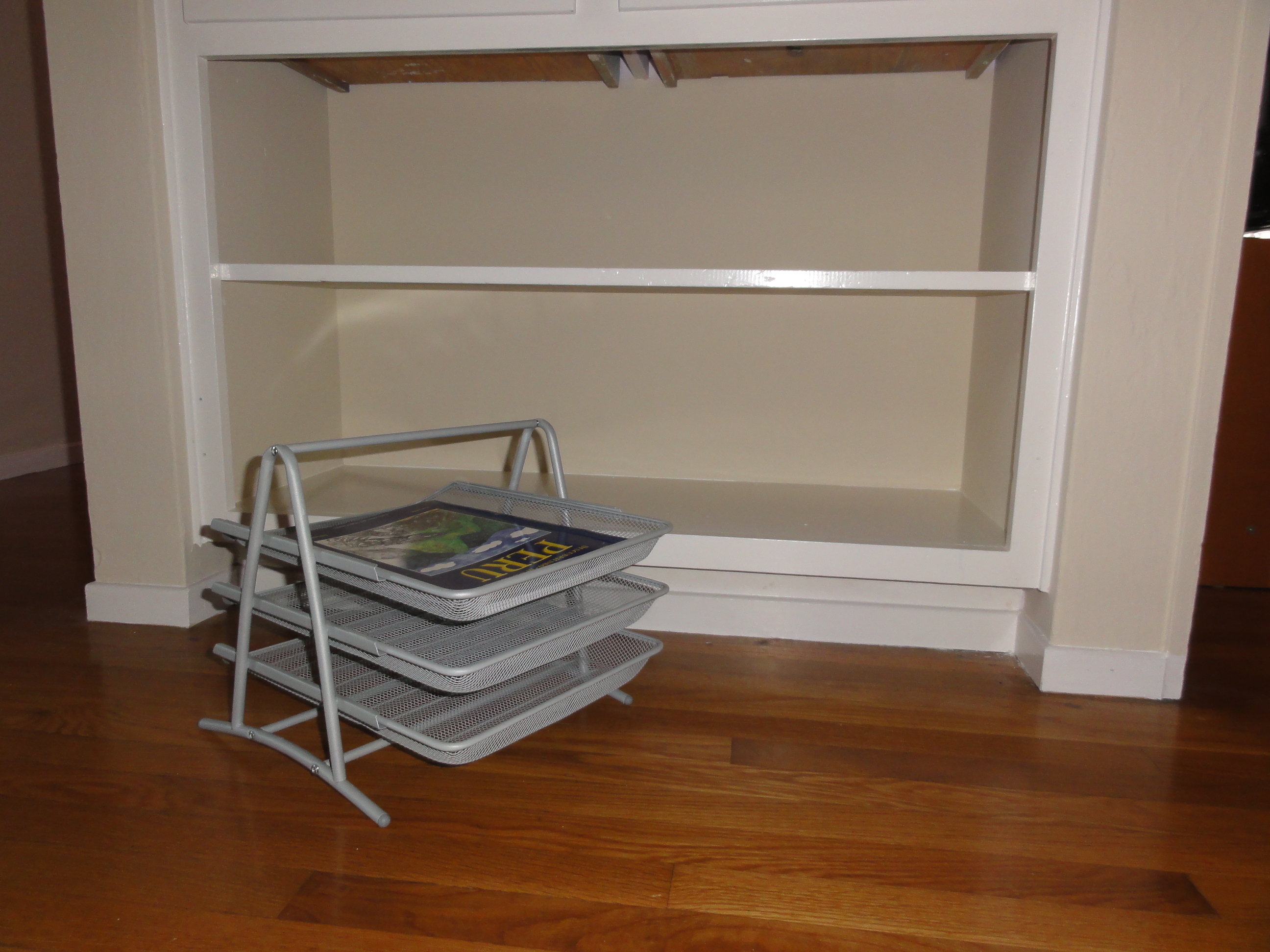
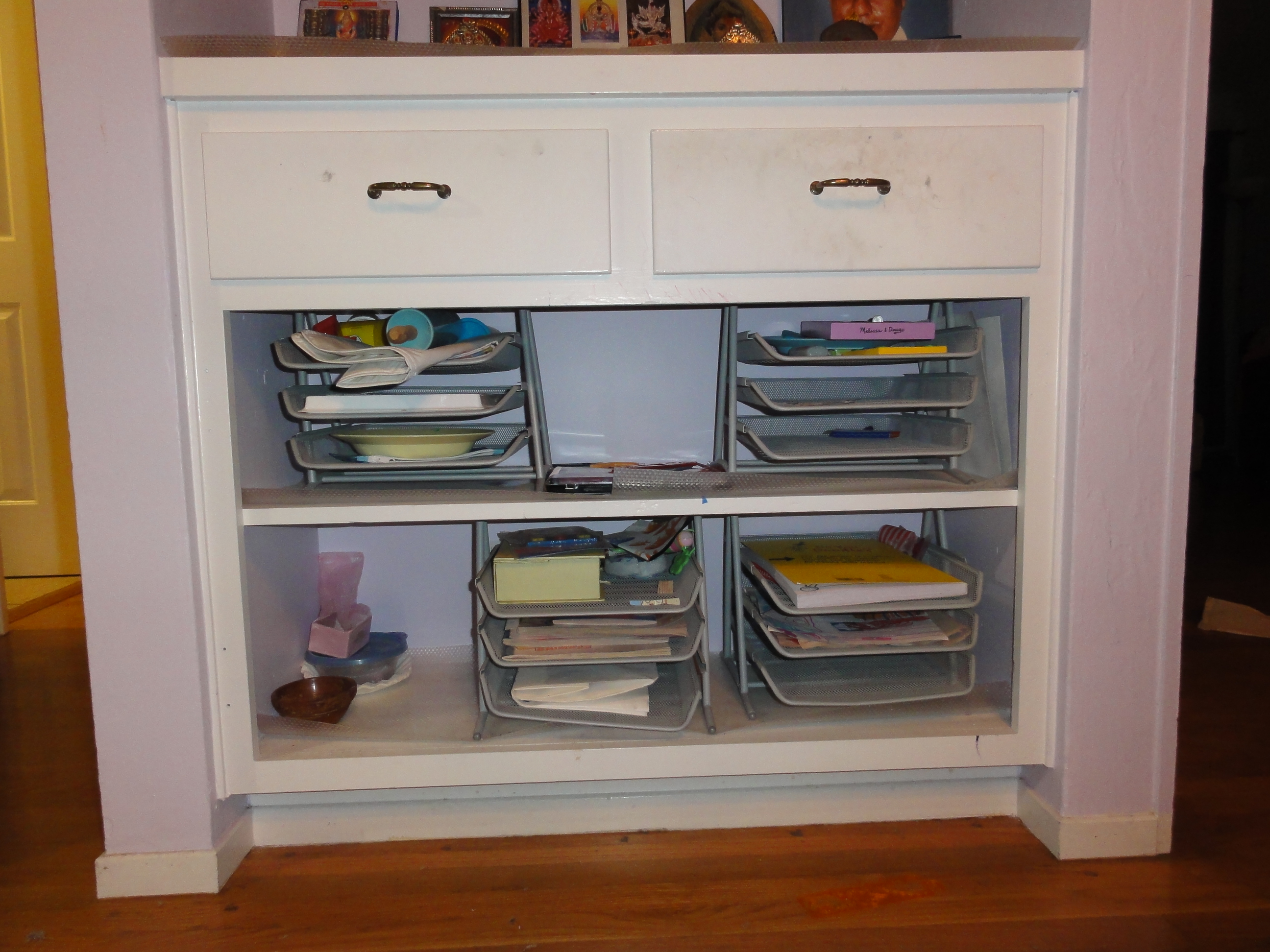
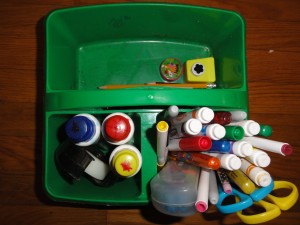
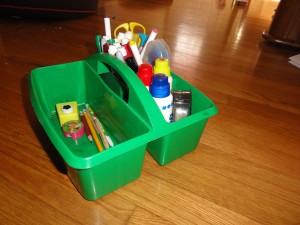
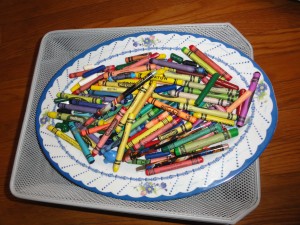
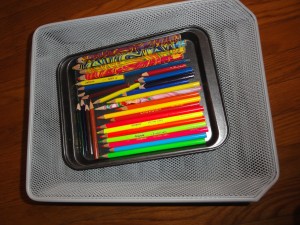
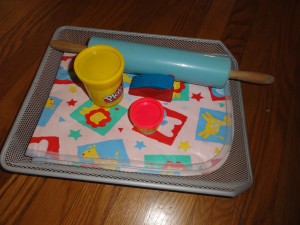
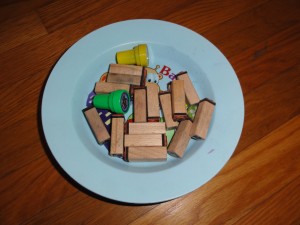
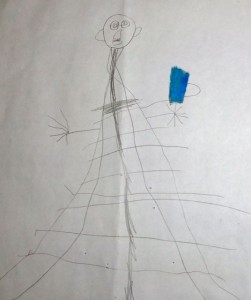
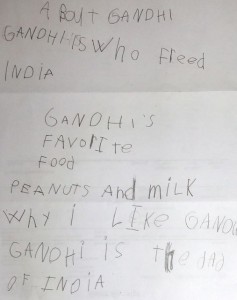
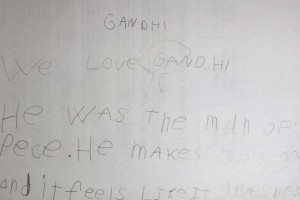

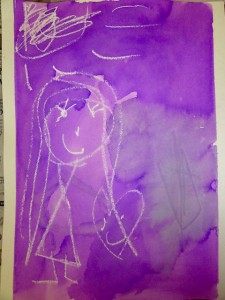
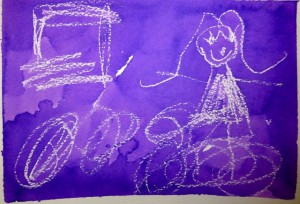










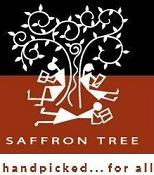
Recent Comments